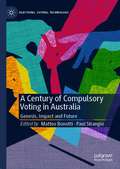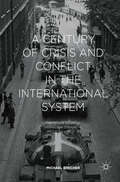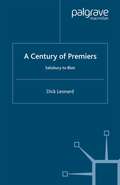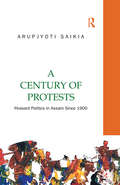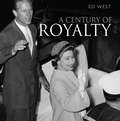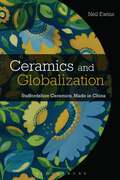- Table View
- List View
Centuries Of Genocide: Essays And Eyewitness Accounts
by Samuel Totten William S. ParsonsThe fourth edition of Centuries of Genocide: Essays and Eyewitness Accounts addresses examples of genocides perpetrated in the nineteenth, twentieth, and twenty-first centuries. Each chapter of the book is written by a recognized expert in the field, collectively demonstrating a wide range of disciplinary perspectives. The book is framed by an introductory essay that spells out definitional issues, as well as the promises, complexities, and barriers to the prevention and intervention of genocide. To help the reader learn about the similarities and differences among the various cases, each case is structured around specific leading questions. In every chapter authors address: Who committed the genocide? How was the genocide committed? Why was the genocide committed? Who were the victims? What were the outstanding historical forces? What was the long-range impact? What were the responses? How do scholars interpret this genocide? How does learning about this genocide contribute to the field of study? While the material in each chapter is based on sterling scholarship and wide-ranging expertise of the authors, eyewitness accounts give voice to the victims. This book is an attempt to provoke the reader into understanding that learning about genocide is important and that we all have a responsibility not to become immune to acts of genocide, especially in the interdependent world in which we live today. Revision highlights include: New chapters on genocide of Native Americans in the nineteenth century, genocide in Australia, and genocide in the Nuba Mountains New chapter authors on Herero genocide and Rwanda genocide Consolidation of the 3 chapters on the Holocaust into one focused case Several chapters from past editions that were omitted are now available on a companion website (Indonesia, Burundi, indigenous peoples)
Centuries of Genocide: Essays and Eyewitness Accounts
by Samuel Totten William S. ParsonsThe fourth edition of Centuries of Genocide: Essays and Eyewitness Accounts addresses examples of genocides perpetrated in the nineteenth, twentieth, and twenty-first centuries. Each chapter of the book is written by a recognized expert in the field, collectively demonstrating a wide range of disciplinary perspectives. The book is framed by an introductory essay that spells out definitional issues, as well as the promises, complexities, and barriers to the prevention and intervention of genocide. To help the reader learn about the similarities and differences among the various cases, each case is structured around specific leading questions. In every chapter authors address: Who committed the genocide? How was the genocide committed? Why was the genocide committed? Who were the victims? What were the outstanding historical forces? What was the long-range impact? What were the responses? How do scholars interpret this genocide? How does learning about this genocide contribute to the field of study? While the material in each chapter is based on sterling scholarship and wide-ranging expertise of the authors, eyewitness accounts give voice to the victims. This book is an attempt to provoke the reader into understanding that learning about genocide is important and that we all have a responsibility not to become immune to acts of genocide, especially in the interdependent world in which we live today. Revision highlights include: New chapters on genocide of Native Americans in the nineteenth century, genocide in Australia, and genocide in the Nuba Mountains New chapter authors on Herero genocide and Rwanda genocide Consolidation of the 3 chapters on the Holocaust into one focused case Several chapters from past editions that were omitted are now available on a companion website (Indonesia, Burundi, indigenous peoples)
Centuries of Genocide: Essays and Eyewitness Accounts
by Samuel Totten William S. ParsonsThe fourth edition of Centuries of Genocide: Essays and Eyewitness Accounts addresses examples of genocides perpetrated in the nineteenth, twentieth, and twenty-first centuries. Each chapter of the book is written by a recognized expert in the field, collectively demonstrating a wide range of disciplinary perspectives. The book is framed by an introductory essay that spells out definitional issues, as well as the promises, complexities, and barriers to the prevention and intervention of genocide. To help the reader learn about the similarities and differences among the various cases, each case is structured around specific leading questions. In every chapter authors address: Who committed the genocide? How was the genocide committed? Why was the genocide committed? Who were the victims? What were the outstanding historical forces? What was the long-range impact? What were the responses? How do scholars interpret this genocide? How does learning about this genocide contribute to the field of study? While the material in each chapter is based on sterling scholarship and wide-ranging expertise of the authors, eyewitness accounts give voice to the victims. This book is an attempt to provoke the reader into understanding that learning about genocide is important and that we all have a responsibility not to become immune to acts of genocide, especially in the interdependent world in which we live today. Revision highlights include: New chapters on genocide of Native Americans in the nineteenth century, genocide in Australia, and genocide in the Nuba Mountains New chapter authors on Herero genocide and Rwanda genocide Consolidation of the 3 chapters on the Holocaust into one focused case Several chapters from past editions that were omitted are now available on a companion website (Indonesia, Burundi, indigenous peoples)
A Century of Compulsory Voting in Australia: Genesis, Impact and Future (Elections, Voting, Technology)
by Matteo Bonotti Paul StrangioCompulsory voting has operated in Australia for a century, and remains the best known and arguably the most successful example of the practice globally. By probing that experience from several disciplinary perspectives, this book offers a fresh, up-to-date insight into the development and distinctive functioning of compulsory voting in Australia. By juxtaposing the Australian experience with that of other representative democracies in Europe and North America, the volume also offers a much needed comparative dimension to compulsory voting in Australia. A unifying theme running through this study is the relationship between compulsory voting and democratic well-being. Can we learn anything from Australia’s experience of the practice that is instructive for the development of institutional bulwarks in an era when democratic politics is under pressure globally? Or is Australia’s case sui generis – best understood in the final analysis as an intriguing outlier?
A Century of Controversy: Ethnological Issues from 1860 to 1960
by Elman R ServiceA Century of Controversy: Ethnological Issues from 1860 to 1960 is an assessment of the history of ethnology in terms of its intellectual progress, with emphasis on the controversial issues that were broached between 1860 and 1960. Two related philosophical or theoretical poses that characterized the prominent ethnological thinkers of this period, and earlier, are related to this phenomenon. One was the prevalent positivism, the other the belief in human progress as a form of social, cultural, and mental evolution. Comprised of 19 chapters, this volume begins by looking at several eminent scholars dealing more closely with the subject of ethnology, including Henry Maine and John F. McLennan in Great Britain; Johann J. Bachofen in Switzerland; and Fustel de Coulanges in France. In particular, the chapter examines the disagreement among Maine, Bachofen, McLennan, and Fustel de Coulanges as to the nature of the earliest society and its form of marriage; the nature of the evolutionary transformations of society (especially from primitive society to civilization); and the actual meaning and function of kinship terminology. The next two chapters describe the positive, useful discoveries as well as the mistakes and weaknesses of Lewis H. Morgan's work, with particular reference to his classificatory kinship nomenclature. Subsequent sections focus on controversies surrounding kinship terminology; social structure; the origins of government; the economic life of primitive peoples; and society and culture. This book will be of interest to scholars of anthropology, archaeology, and ethnology.
A Century of Crisis and Conflict in the International System: Theory and Evidence: Intellectual Odyssey III
by Michael BrecherThis book is designed to present a fully developed theory of international crisis and conflict, along with substantial evidence of these two closely related phenomena. The book begins with a discussion of these topics at a theoretical level, defining and elaborating on core concepts: international crisis, interstate conflict, severity, and impact. This is followed by a discussion of the international system, along with two significant illustrations, the Berlin Blockade crisis (1948) and the India-Pakistan crisis over Kashmir (1965-66). The book then presents a unified model of crisis, focusing on the four phases of an international crisis, which incorporate the four periods of foreign policy crises for individual states. Findings from thirteen conflicts representing six regional clusters are then analyzed, concluding with a set of hypotheses and evidence on conflict onset, persistence, and resolution.
A Century of Development in Taiwan: From Colony to Modern State
Most colonies became independent countries after the end of World War II, while few of them became modernized even after decades of their independence. Taiwan is one of the few to become a modern state with remarkable achievements in its economic, socio-cultural, and political development.In 1921, Taiwanese intellectuals initiated a Petition Movement for the Establishment of a Taiwanese Parliament under the colonial government. Leaders of the enlightenment also established the Taiwan Cultural Association (TCA) on October 17, 1921. These two movements led to a series of socio-cultural, political, and economic developments during the past century. This book addresses the path and trajectory of the emergence of Taiwan from a colony to a modern state in the past century. It contains four major sections on identity and political developments and explores international relations, economic development. educational and societal development, and culture and literature development.This thorough exploration will prove invaluable to graduate and undergraduate students in Taiwan history, literature, and the cultural and political economy of development as well as students studying East Asia. It offers the same wealth of information to researchers and practitioners in Taiwan-China-US trilateral relations and in cultural anthropology and practices in East Asia politics and business.
A Century of East African Integration
by Claire A. Amuhaya Denis A. DegterevThis book presents a comprehensive analysis of regional integration in East Africa in the last century, reflecting the general trends of integration processes in the East Africa sub-region with a focus on the East African Community. Particular attention is paid to the cyclicality of integration dynamics, as well as the analysis of the interconnection and competition between different regional organizations in East Africa. In this context, the specificity of the so-called overlapping membership of African states in regional organizations with similar roles but conflicting treaties and mandates is explored. This situation to a certain extent affects the relations of states in the region with external actors specifically trade negotiations with EU that the book comprehensively analyses. This book therefore offers a deeper understanding of the processes of regional integration in East Africa that had been missed before, which reflects the general integration dynamics on the African continent.
A Century of Fiscal Squeeze Politics: 100 Years of Austerity, Politics, and Bureaucracy in Britain
by Christopher Hood Rozana HimazThis volume identifies and compares 'fiscal squeezes' (major efforts to cut public spending and/or raise taxes) in the UK over a century from 1900 to 2015. The authors examine how different the politics of fiscal squeeze and austerity is today from what it was a century ago, how (if at all) fiscal squeezes reshaped the state and the provision of public services, and how political credit and blame played out after austerity episodes. The analysis is both quantitative and qualitative, starting with reported financial outcomes from historical statistics and then going behind those numbers to explore the political choices and processes in play. This analysis identifies some patterns that have not been explained or even recognized in earlier works on retrenchment and austerity. For example, it identifies a long term shift from what it terms a 'surgery without anaesthetics' approach (deep but short-lived episodes of spending restraint or tax increases) in the earlier part of the period towards a 'boiling frogs' approach (episodes in which the pain is spread out over a longer period) in more recent decades. It also identifies a curious reduction of revenue-led squeezes in more recent decades, and a puzzle over why blame-avoidance logic only led to outsourcing painful decisions over squeeze in a minority of cases. Furthermore, the volume's distinctive approach to classifying types of fiscal squeezes and qualitatively assessing their intensity seeks to solve the puzzle as to why voter'punishment' of governments that impose austerity policies seems to be so erratic.
A Century of Fiscal Squeeze Politics: 100 Years of Austerity, Politics, and Bureaucracy in Britain
by Christopher Hood Rozana HimazThis volume identifies and compares 'fiscal squeezes' (major efforts to cut public spending and/or raise taxes) in the UK over a century from 1900 to 2015. The authors examine how different the politics of fiscal squeeze and austerity is today from what it was a century ago, how (if at all) fiscal squeezes reshaped the state and the provision of public services, and how political credit and blame played out after austerity episodes. The analysis is both quantitative and qualitative, starting with reported financial outcomes from historical statistics and then going behind those numbers to explore the political choices and processes in play. This analysis identifies some patterns that have not been explained or even recognized in earlier works on retrenchment and austerity. For example, it identifies a long term shift from what it terms a 'surgery without anaesthetics' approach (deep but short-lived episodes of spending restraint or tax increases) in the earlier part of the period towards a 'boiling frogs' approach (episodes in which the pain is spread out over a longer period) in more recent decades. It also identifies a curious reduction of revenue-led squeezes in more recent decades, and a puzzle over why blame-avoidance logic only led to outsourcing painful decisions over squeeze in a minority of cases. Furthermore, the volume's distinctive approach to classifying types of fiscal squeezes and qualitatively assessing their intensity seeks to solve the puzzle as to why voter'punishment' of governments that impose austerity policies seems to be so erratic.
A Century of Genocide: Utopias of Race and Nation
by Eric D. WeitzWhy did the twentieth century witness unprecedented organized genocide? Can we learn why genocide is perpetrated by comparing different cases of genocide? Is the Holocaust unique, or does it share causes and features with other cases of state-sponsored mass murder? Can genocide be prevented? Blending gripping narrative with trenchant analysis, Eric Weitz investigates four of the twentieth century's major eruptions of genocide: the Soviet Union under Stalin, Nazi Germany, Cambodia under the Khmer Rouge, and the former Yugoslavia. Drawing on historical sources as well as trial records, memoirs, novels, and poems, Weitz explains the prevalence of genocide in the twentieth century--and shows how and why it became so systematic and deadly. Weitz depicts the searing brutality of each genocide and traces its origins back to those most powerful categories of the modern world: race and nation. He demonstrates how, in each of the cases, a strong state pursuing utopia promoted a particular mix of extreme national and racial ideologies. In moments of intense crisis, these states targeted certain national and racial groups, believing that only the annihilation of these "enemies" would enable the dominant group to flourish. And in each instance, large segments of the population were enticed to join in the often ritualistic actions that destroyed their neighbors. This book offers some of the most absorbing accounts ever written of the population purges forever associated with the names Stalin, Hitler, Pol Pot, and Milosevic. A controversial and richly textured comparison of these four modern cases, it identifies the social and political forces that produce genocide.
A Century of Genocide: Utopias of Race and Nation (PDF)
by Eric D. WeitzWhy did the twentieth century witness unprecedented organized genocide? Can we learn why genocide is perpetrated by comparing different cases of genocide? Is the Holocaust unique, or does it share causes and features with other cases of state-sponsored mass murder? Can genocide be prevented? Blending gripping narrative with trenchant analysis, Eric Weitz investigates four of the twentieth century's major eruptions of genocide: the Soviet Union under Stalin, Nazi Germany, Cambodia under the Khmer Rouge, and the former Yugoslavia. Drawing on historical sources as well as trial records, memoirs, novels, and poems, Weitz explains the prevalence of genocide in the twentieth century--and shows how and why it became so systematic and deadly. Weitz depicts the searing brutality of each genocide and traces its origins back to those most powerful categories of the modern world: race and nation. He demonstrates how, in each of the cases, a strong state pursuing utopia promoted a particular mix of extreme national and racial ideologies. In moments of intense crisis, these states targeted certain national and racial groups, believing that only the annihilation of these "enemies" would enable the dominant group to flourish. And in each instance, large segments of the population were enticed to join in the often ritualistic actions that destroyed their neighbors. This book offers some of the most absorbing accounts ever written of the population purges forever associated with the names Stalin, Hitler, Pol Pot, and Milosevic. A controversial and richly textured comparison of these four modern cases, it identifies the social and political forces that produce genocide.
A Century of Global Economic Crises: Monetary Policy in Search of An Anchor
by Lúcio Vinhas de SouzaThis book explores the end of the era of low inflation and stable price increases, known as “The Great Moderation”, and the impact this will have on monetary policy. The macroeconomic trends and economic policy issues observed within developed countries over the last 70 years are linked with the economic theory debates of the time to highlight how the current economic challenges came about. The limitations of past economic policies are highlighted to help create a new policy framework for an era defined by high inflation, low economic growth, large budget deficits, and increased private sector debt.This book presents a new understanding of monetary policy that engages with the changing behaviour of economic agents. It will be relevant to researchers and policymakers interested in monetary policy and the political economy.
A Century of Labour
by Jon CruddasBritain’s first Labour government took office on 22 January 1924. Its centenary provides an opportunity to reassess the party's performance over the last 100 years, and with an election pending, the character and purpose of the modern party. Labour defined the dominant political settlement of much of the Twentieth Century: the welfare state. It has achieved much in pursuit of material change, social reform and equality. It has challenged patriarchy, racism and the legacy of imperialism, promoted human rights and delivered democratic and constitutional renewal. Yet any honest assessment must acknowledge a century littered with failures and missed opportunities. In this compelling book, Jon Cruddas, one of the country's foremost experts on Labour politics, details the vivid personalities and epic factional battles, the immense achievements and profound disappointments that define a century of Labour. Uniquely framed around competing visions of socialist justice within the Party, he provides a way to rethink Labour history, the divisions and factions on the left and to reassess key figures at the helm of the movement from Keir Hardie through to Keir Starmer.
A Century of Premiers: Salisbury to Blair
by D. LeonardDuring the course of the Twentieth Century, nineteen men and one woman - from Robert Cecil, Third Marquis of Salisbury to Tony Blair - have occupied the post of Prime Minister of the United Kingdom.
A Century of Protests: Peasant Politics in Assam Since 1900
by Arupjyoti SaikiaAddressing an important gap in the historiography of modern Assam, this book traces the relatively unexplored but profound transformations in the agrarian landscape of late- and post-colonial Assam that were instrumental in the making of modern Assamese peasantry and rural politics. It discusses the changing relations between various sections of peasantry, state, landed gentry, and politics of different ideological hues — nationalist, communist and socialist — and shows how a primarily agrarian question concerning peasantry came to occupy the centre stage in the nationalist politics of the state. It will especially interest scholars of history, agrarian and peasant studies, sociology, and contemporary politics, as also those concerned with Northeast India.
A Century of Protests: Peasant Politics in Assam Since 1900
by Arupjyoti SaikiaAddressing an important gap in the historiography of modern Assam, this book traces the relatively unexplored but profound transformations in the agrarian landscape of late- and post-colonial Assam that were instrumental in the making of modern Assamese peasantry and rural politics. It discusses the changing relations between various sections of peasantry, state, landed gentry, and politics of different ideological hues — nationalist, communist and socialist — and shows how a primarily agrarian question concerning peasantry came to occupy the centre stage in the nationalist politics of the state. It will especially interest scholars of history, agrarian and peasant studies, sociology, and contemporary politics, as also those concerned with Northeast India.
A Century of Royalty (Century Of Ser. #1)
by Edward WestOver the last century Britain has witnessed a royal family saga compelling, tumultuous and heartwarming. The constitution has been thrown into crisis by an abdication, royal divorces have become commonplace, coronations and jubilees have brought the nation together – and though Princess Diana's death precipitated perhaps the most serious turn in public opinion yet, the Windsors' place in our hearts was confirmed beyond any doubt by Elizabeth II's Diamond Jubilee and the birth of the Duke and Duchess of Cambridge's son, Prince George. With full-page illustrations from the Daily Mirror's archives and illuminating explanatory text, this book is a unique look at one hundred years of royalty in Britain. The British Royal Family: beloved worldwide, poised and gracious, and above all resilient. With striking images from the Daily Mirror's famous archive and expert text from Ed West, A Century of Royalty looks from unexpected angles at these fascinating lives, controversies and traditions, from Edward VII's coronation to the birth of Prince George in 2013.
A Century of Royalty (Century Of #1)
by Edward WestOver the last century Britain has witnessed a royal family saga compelling, tumultuous and heartwarming. The constitution has been thrown into crisis by an abdication, royal divorces have become commonplace, coronations and jubilees have brought the nation together – and though Princess Diana's death precipitated perhaps the most serious turn in public opinion yet, the Windsors' place in our hearts was confirmed beyond any doubt by Elizabeth II's Diamond Jubilee and the birth of the Duke and Duchess of Cambridge's son, Prince George. With full-page illustrations from the Daily Mirror's archives and illuminating explanatory text, this book is a unique look at one hundred years of royalty in Britain. The British Royal Family: beloved worldwide, poised and gracious, and above all resilient. With striking images from the Daily Mirror's famous archive and expert text from Ed West, A Century of Royalty looks from unexpected angles at these fascinating lives, controversies and traditions, from Edward VII's coronation to the birth of Prince George in 2013.
A Century of Sovereign Ratings
by Norbert GaillardThe financial difficulties experienced by Greece since 2009 serve as a reminder that countries (i.e., sovereigns) may default on their debt. Many observers considered the financial turmoil was behind us because major advanced countries had adopted stimulus packages to prevent banks from going bankrupt. However, there are rising doubts about the creditworthiness of several advanced countries that participated in the bailouts. In this uncertain context, it is particularly crucial to be knowledgeable about sovereign ratings. This book provides the necessary broad overview, which will be of interest to both economists and investors alike.Chapter 1 presents the main issues that are addressed in this book. Chapters 2, 3, and 4 provide the key notions to understand sovereign ratings. Chapter 2 presents an overview of sovereign rating activity since the first such ratings were assigned in 1918. Chapter 3 analyzes the meaning of sovereign ratings and the significance of rating scales; it also describes the refinement of credit rating policies and tools. Chapter 4 focuses on the sovereign rating process. Chapters 5 and 6 open the black box of sovereign ratings. Chapter 5 compares sovereign rating methodologies in the interwar years with those in the modern era. After examining how rating agencies have amended their methodologies since the 1990s, Chapter 6 scrutinizes rating disagreements between credit rating agencies (CRAs). Chapters 7 and 8 measure the performances of sovereign ratings by computing default rates and accuracy ratios: Chapter 7 looks at the interwar years and Chapter 8 at the modern era. The two chapters assess which CRA assigns the most accurate ratings during the respective periods. Chapters 9 and 10 compare the perception of sovereign risk by the CRAs and market participants. Chapter 9 focuses on the relation between JP Morgan Emerging Markets Bond Index Global spreads and emerging countries’ sovereign ratings for the period 1993–2007. Chapter 10 compares the eurozone members’ sovereign ratings with Credit Default Swap-Implied Ratings (CDS-IRs) during the Greek debt crisis of November 2009–May 2010.
CEO, China: The Rise of Xi Jinping
by Kerry BrownChina has become the powerhouse of the world economy, its incredible boom overseen by the elite members of the secretive and all-powerful communist party. But since the election of Xi Jinping as General Secretary, life at the top in China has changed. Under the guise of a corruption crackdown, which has seen his rivals imprisoned, Xi Jinping has been quietly building one of the most powerful leaderships modern China has ever seen. In CEO China, the noted China expert Kerry Brown reveals the hidden story of the rise of the man dubbed the 'Chinese Godfather'. Brown investigates his relationship with his revolutionary father, who was expelled by Mao during the Cultural Revolution, his business dealings and allegiances in China's regional power struggles and his role in the internal battle raging between the old men of the Deng era and the new super-rich 'princelings'. Xi Jinping's China is powerful, aggressive and single-minded and this book will become a must-read for the Western world.
CEO Society: The Corporate Takeover of Everyday Life
by Peter Bloom Carl RhodesChief Executive Officers (CEOs) have become the cultural icons of the 21st century. Figures like Steve Jobs and Mark Zuckerberg are held up as role models who epitomise the modern pursuit of innovation, wealth and success. We now live, Bloom and Rhodes argue, in a 'CEO society' – a society where corporate leadership has become the model for transforming not just business, but all spheres of life, where everyone from politicians to jobseekers to even those seeking love are expected to imitate the qualities of the lionized corporate executive.But why, in the wake of the failings exposed by the 2008 financial crisis, does the corporate ideal continue to exert such a grip on popular attitudes? In this insightful new book, Bloom and Rhodes examine the rise of the CEO society, and how it has started to transform governments, culture and the economy. This influence, they argue, holds troubling implications for the future of democracy - as evidenced by the disturbing political rise of Donald Trump in the US - and for our society as a whole.
CEO Society: The Corporate Takeover of Everyday Life
by Peter Bloom Carl RhodesChief Executive Officers (CEOs) have become the cultural icons of the 21st century. Figures like Steve Jobs and Mark Zuckerberg are held up as role models who epitomise the modern pursuit of innovation, wealth and success. We now live, Bloom and Rhodes argue, in a 'CEO society' – a society where corporate leadership has become the model for transforming not just business, but all spheres of life, where everyone from politicians to jobseekers to even those seeking love are expected to imitate the qualities of the lionized corporate executive.But why, in the wake of the failings exposed by the 2008 financial crisis, does the corporate ideal continue to exert such a grip on popular attitudes? In this insightful new book, Bloom and Rhodes examine the rise of the CEO society, and how it has started to transform governments, culture and the economy. This influence, they argue, holds troubling implications for the future of democracy - as evidenced by the disturbing political rise of Donald Trump in the US - and for our society as a whole.
Ceramics and Globalization: Staffordshire Ceramics, Made in China
by Neil EwinsNeil Ewins' study of the Staffordshire potteries in a period of great global change traces how ceramics production has been affected by globalisation in both familiar and unexpected ways.Although many manufacturers such as Wedgwood initially moved production to cheaper labour markets in East Asia, others remained in or returned to England once it became clear that outsourcing manufacturing was affecting the brand value and customer perception of their products. Neil Ewins explores the complex behaviour of the UK ceramics industry, using a combination of evidence from the press, trade journals, ceramic objects, and primary interview evidence of manufacturers, retailers and a ceramic designer. Ewins suggests that, although the surface designs of UK ceramics invariably reflect diverse cultural and stylistic influences, a notion of authenticity often still resides in the place and context in which the ceramic product was originally made. Overall, the book argues that UK ceramics remain culturally complex because of issues of supply and demand, and ties to heritage, imagined or otherwise. Within a context of globalization, the book highlights compelling issues which have huge ramifications on UK manufacturing futures.
Ceramics and Globalization: Staffordshire Ceramics, Made in China
by Neil EwinsNeil Ewins' study of the Staffordshire potteries in a period of great global change traces how ceramics production has been affected by globalisation in both familiar and unexpected ways.Although many manufacturers such as Wedgwood initially moved production to cheaper labour markets in East Asia, others remained in or returned to England once it became clear that outsourcing manufacturing was affecting the brand value and customer perception of their products. Neil Ewins explores the complex behaviour of the UK ceramics industry, using a combination of evidence from the press, trade journals, ceramic objects, and primary interview evidence of manufacturers, retailers and a ceramic designer. Ewins suggests that, although the surface designs of UK ceramics invariably reflect diverse cultural and stylistic influences, a notion of authenticity often still resides in the place and context in which the ceramic product was originally made. Overall, the book argues that UK ceramics remain culturally complex because of issues of supply and demand, and ties to heritage, imagined or otherwise. Within a context of globalization, the book highlights compelling issues which have huge ramifications on UK manufacturing futures.


